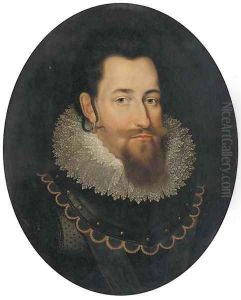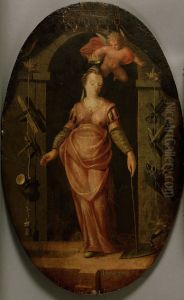Pieter Isaacsz Paintings
Pieter Isaacsz, also known as Pieter Isaac or Peter Isaac, was a notable Dutch Golden Age painter, born in Elsinore, Denmark, in 1569. Despite his Danish birth, Isaacsz is often associated with Dutch art due to his significant contribution to the period and the fact that he spent a considerable part of his career in the Netherlands. He was also active as an art dealer, diplomat, and advisor on cultural matters. His works are known for their intricate detail and the use of light, typical of the Northern Mannerist style that he helped to propagate in the late 16th and early 17th centuries.
Isaacsz was the son of an affluent Danish merchant and was sent to the Netherlands at a young age to receive his education. He likely trained in the studio of the prominent Mannerist painter Cornelis van Haarlem, where he would have been exposed to the blend of Italianate and Northern Renaissance styles. This training proved influential in his development as an artist, as he became known for combining classical themes with the detailed realism characteristic of Northern European painting.
In his early career, Isaacsz painted historical scenes, portraits, and allegories. He was particularly adept at large-scale compositions filled with classical references and allegorical figures, which were popular with the intellectual elite of the period. His works demonstrated a mastery of anatomy, perspective, and a vivid sense of drama, which made them appealing to patrons across Europe.
Around 1601, Isaacsz was appointed as a court painter to the Danish king, Christian IV. However, he continued to maintain strong ties with the Dutch art scene and engaged in art dealing, selling works by Dutch artists to Scandinavian clients. During this time, he also traveled as a diplomat on behalf of the Danish king, which allowed him to establish a broad network of contacts throughout Europe.
Isaacsz's career as a diplomat and art dealer was closely intertwined with his artistic work. He was instrumental in the cultural exchange between the Netherlands and Denmark and contributed to the spread of Dutch artistic influence in the Nordic countries. His role in the cultural milieu of the time was significant, not just as a creator of art, but also as a mediator and promoter of artistic ideas and trends.
Pieter Isaacsz died in 1625 in Amsterdam. His legacy is preserved in the artworks that survive him, and his influence as a cultural intermediary is recognized as an important aspect of the Dutch Golden Age's international reach. His paintings can be found in various museums and collections, representing a unique blend of the grandeur of Mannerism with the emerging Baroque sensibility that was to dominate European art in the subsequent century.

